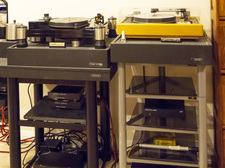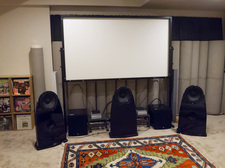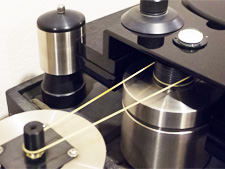It’s the time of year for saving money!
Yesterday I became officially moved into my new house. And what fortuitous occurrence has brought closure to my move? Finally getting 30 cubes of records and the remaining parts and pieces of my turntables into my listening room, and setting up the turntables to the point where they actually work again. A house without a turntable isn’t a home in my book.
 Weather, the location of my old home’s driveway, and the sheer weight of all my records combined to postpone the final installment of my move from the end of February clear to the beginning of April. Thirty cubes, each weighing approximately 40 lbs., combined to tip the scales at 1,200 lbs. And then there were the books (another 30-plus boxes) along with the furniture, which couldn’t make it onto the first two 16-foot moving trucks.
Weather, the location of my old home’s driveway, and the sheer weight of all my records combined to postpone the final installment of my move from the end of February clear to the beginning of April. Thirty cubes, each weighing approximately 40 lbs., combined to tip the scales at 1,200 lbs. And then there were the books (another 30-plus boxes) along with the furniture, which couldn’t make it onto the first two 16-foot moving trucks.
The load out and load in went smoothly, so smoothly that by 3:00 PM I began sorting out the pieces and parts of my turntables and began assembling them. Neither of the VPI turntables I own are plug-and-play — both have gone through multiple updates and small modifications to the point that they are no longer stock, so assembling them is an exercise in memory. How did everything go together? After two months in storage that can lead to some head scratching. During the process, the last words of Shakespeare’s King Richard the III come to mind: “For want of a nail a kingdom was lost.”
 In all the years I’ve been an audio reviewer I’ve never had two turntables in the same system, but in my new house that is what I’ve got, and I think, once I get them set up, it’s going to be ear-opening. (Actually, it already has been.)
In all the years I’ve been an audio reviewer I’ve never had two turntables in the same system, but in my new house that is what I’ve got, and I think, once I get them set up, it’s going to be ear-opening. (Actually, it already has been.)
My oldest turntable is a VPI HW-19 that has had its motor replaced by an “outboard” motor that sits in a Brightstar sand base. The HW-19 also has a PLC power conditioner and speed adjustment box. The tonearm for the HW-19 is the last version of Lou Souther’s SLA-3 lateral tracking tonearm (the design was sold to Clearaudio who continue to make tonearms based on Souther’s design). My phono cartridge is a Denon 103 that has been modified by A.J. VanDenHul with his cutting-shape stylus. The outboard phono preamplifier for this turntable is the Michael Yee PHE-1.
My other turntable is a VPI TNT III with outboard motor, flywheel, air-bladder columns, Brightstar sand base, Brightstar air support platform, and original VPI TNT turntable stand. The TNT has a Graham 1.5 arm with a Clearaudio Victory II cartridge. The phono preamp for this turntable is John Curl’s legendary Vendetta 2B dual mono preamp.
Setting up both turntables took me a couple of hours. The most time-consuming part is getting all the belts set up optimally on the TNT. The only glitch in the whole process was when I first set up the two tables I mixed up the two VPI PLC devices so when I turned on the TNT its motor didn’t have enough torque to bring the table up to speed. Switching the PLCs solved the problem.
 What is it like listening to a record after several months of going without? Revelatory.
What is it like listening to a record after several months of going without? Revelatory.
Anyone who reads my reviews knows that I will never be confused with Michael Fremer. I am not a vinyl evangelist. But when I put my pressing of B.B. King’s Live at the Regal album on the TNT and compared it to the same album streamed from Tidal into my Mac Mini and then to a PS Audio DSD DAC, it was obvious that great analog still has some magic that eludes a FLAC/Redbook digital file. It’s not the big stuff, like frequency response or bass extension where analog still rules, but in the subtleties — the way space was illuminated more completely by the LP — instead of a curtain of audience sound as on the digital version, on the LP each audience exclamation comes from a different and precise location depth-wise. Does this “prove” that analog is still superior? Nope. But it does prove that the original vinyl version of Live at the Regal is still superior to the current 44.1/16 digital one.
When it comes to a choice between 44.1/16 digital and analog LPs, it hasn’t been a case of digital or analog “ruling” for years, but at this point it really depends on the quality of the mastering and recording (both on the digital and the analog side) that determines whether the LP or the digital file is closer to the original studio sound. But to even begin to have this conversation you need to have a system that has both analog and digital sources.
Now that I’ve got my turntables set up I can honestly write that I have finally arrived at my new home. Being home is good.





